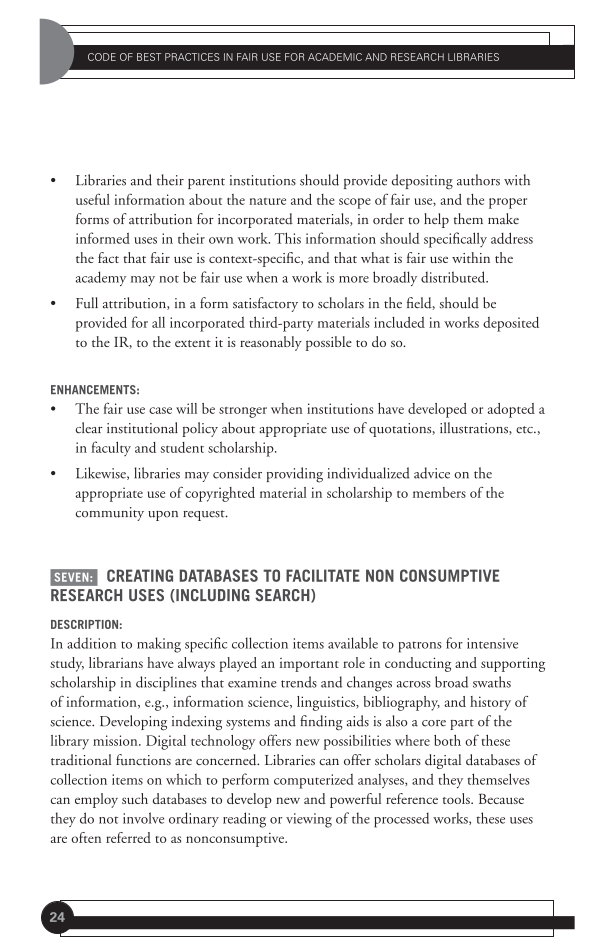CODE OF BEST PRACTICES IN FAIR USE FOR ACADEMIC AND RESEARCH LIBRARIES
24
• Libraries and their parent institutions should provide depositing authors with
useful information about the nature and the scope of fair use, and the proper
forms of attribution for incorporated materials, in order to help them make
informed uses in their own work. This information should specifically address
the fact that fair use is context-specific, and that what is fair use within the
academy may not be fair use when a work is more broadly distributed.
• Full attribution, in a form satisfactory to scholars in the field, should be
provided for all incorporated third-party materials included in works deposited
to the IR, to the extent it is reasonably possible to do so.
ENHANCEMENTS:
• The fair use case will be stronger when institutions have developed or adopted a
clear institutional policy about appropriate use of quotations, illustrations, etc.,
in faculty and student scholarship.
• Likewise, libraries may consider providing individualized advice on the
appropriate use of copyrighted material in scholarship to members of the
community upon request.
SEVEN: CREATING DATABASES TO FACILITATE NON CONSUMPTIVE
RESEARCH USES (INCLUDING SEARCH)
DESCRIPTION:
In addition to making specific collection items available to patrons for intensive
study, librarians have always played an important role in conducting and supporting
scholarship in disciplines that examine trends and changes across broad swaths
of information, e.g., information science, linguistics, bibliography, and history of
science. Developing indexing systems and finding aids is also a core part of the
library mission. Digital technology offers new possibilities where both of these
traditional functions are concerned. Libraries can offer scholars digital databases of
collection items on which to perform computerized analyses, and they themselves
can employ such databases to develop new and powerful reference tools. Because
they do not involve ordinary reading or viewing of the processed works, these uses
are often referred to as nonconsumptive.
24
• Libraries and their parent institutions should provide depositing authors with
useful information about the nature and the scope of fair use, and the proper
forms of attribution for incorporated materials, in order to help them make
informed uses in their own work. This information should specifically address
the fact that fair use is context-specific, and that what is fair use within the
academy may not be fair use when a work is more broadly distributed.
• Full attribution, in a form satisfactory to scholars in the field, should be
provided for all incorporated third-party materials included in works deposited
to the IR, to the extent it is reasonably possible to do so.
ENHANCEMENTS:
• The fair use case will be stronger when institutions have developed or adopted a
clear institutional policy about appropriate use of quotations, illustrations, etc.,
in faculty and student scholarship.
• Likewise, libraries may consider providing individualized advice on the
appropriate use of copyrighted material in scholarship to members of the
community upon request.
SEVEN: CREATING DATABASES TO FACILITATE NON CONSUMPTIVE
RESEARCH USES (INCLUDING SEARCH)
DESCRIPTION:
In addition to making specific collection items available to patrons for intensive
study, librarians have always played an important role in conducting and supporting
scholarship in disciplines that examine trends and changes across broad swaths
of information, e.g., information science, linguistics, bibliography, and history of
science. Developing indexing systems and finding aids is also a core part of the
library mission. Digital technology offers new possibilities where both of these
traditional functions are concerned. Libraries can offer scholars digital databases of
collection items on which to perform computerized analyses, and they themselves
can employ such databases to develop new and powerful reference tools. Because
they do not involve ordinary reading or viewing of the processed works, these uses
are often referred to as nonconsumptive.


































